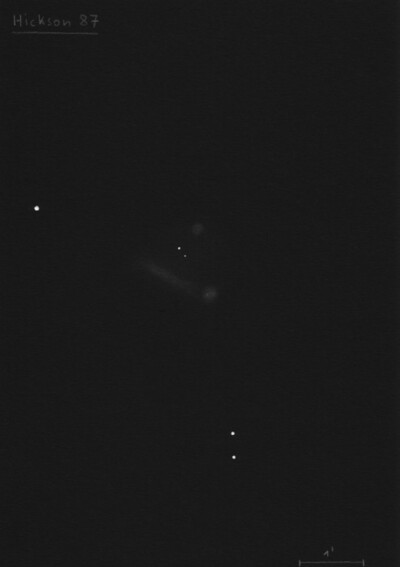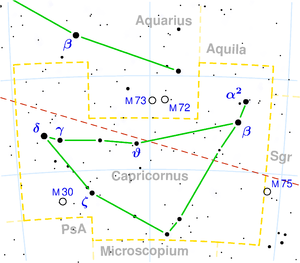 A faint zodiac constellation of the southern sky between Aquarius and Sagittarius. The constellation consists of faint stars forming a distorted triangle shape, none brighter than 3mag. It is reached by the conjunction of two bright stars, Vega and Altair. Nearby are other water constellations: Aquarius, Pisces, Cetus and Southern Pisces - the Sun's passage through this region marked a period of rainy weather in the eastern Mediterranean and Middle East. Because Capricornus is very good at jumping on rocks, it made its way up into the sky as a symbol of the rising Sun - the return of longer days and a harbinger of spring. In fact, 2,000 years ago, the Sun passed through Capricornus at the time of the winter solstice, was lowest in the sky, and began to rise higher and higher in the celestial vault as it moved to the next constellation. However, this has long been untrue. Due to precession, the Sun passes through the constellation from January 20 to February 15, and at the time of the winter solstice it is in Sagittarius - today the southernmost constellation of the zodiac. However, the sign of Capricornus remains the sign of the winter solstice to this day, and the vertex of the southern hemisphere from which the Sun turns back north is called the vertex of Capricornus.
A faint zodiac constellation of the southern sky between Aquarius and Sagittarius. The constellation consists of faint stars forming a distorted triangle shape, none brighter than 3mag. It is reached by the conjunction of two bright stars, Vega and Altair. Nearby are other water constellations: Aquarius, Pisces, Cetus and Southern Pisces - the Sun's passage through this region marked a period of rainy weather in the eastern Mediterranean and Middle East. Because Capricornus is very good at jumping on rocks, it made its way up into the sky as a symbol of the rising Sun - the return of longer days and a harbinger of spring. In fact, 2,000 years ago, the Sun passed through Capricornus at the time of the winter solstice, was lowest in the sky, and began to rise higher and higher in the celestial vault as it moved to the next constellation. However, this has long been untrue. Due to precession, the Sun passes through the constellation from January 20 to February 15, and at the time of the winter solstice it is in Sagittarius - today the southernmost constellation of the zodiac. However, the sign of Capricornus remains the sign of the winter solstice to this day, and the vertex of the southern hemisphere from which the Sun turns back north is called the vertex of Capricornus.
Although Capricorn is located just east of the rich Milky Way region in Sagittarius and occupies a good portion of the sky, it is surprisingly poor in deepsky objects. The region does, however, contain some beautiful double and multiple stars, suitable for binoculars or small telescopes, and in their wide field of view they can look almost like a loose open star cluster. Capricorn, on the other hand, boasts just one interesting globular cluster - M30. Near the star μ Capricorn, the Berlin astronomer Johann Gottfried Galle found another planet in our solar system - Neptune - in 1846, based on Leverrier's calculations.
Deneb Algedi (δ Cap) - The brightest star of the constellation. It is an eclipsing variable star of the Algol type, but its brightness varies only in the range of 2.9mag to 3.1mag, which is difficult to observe with the naked eye. It is located at a distance of 38 light-years.
Dabih Major (β Cap) - It is a yellow spectral binary star with a brightness of 3.3mag and an invisible companion that orbits it every 1374 days, located 650 light-years away. At a separation of 205", there is a blue companion Dabih Minor - β1, with a brightness of 6mag. It is located at a distance of 328 light-years. The whole system is completed by a third yellow star with a magnitude of 9mag, and in larger telescopes, a faint pair of stars with a magnitude of 13mag.
Prima Giedy (α1 Cap) - The brightness of 4.2 mag, together with α2 (Secunda Giedo - 3.6 mag), forms an optical double star that can be distinguished with the naked eye under favorable conditions, in the northwest corner of the "triangular" constellation. The components are separated by 378 arcseconds, which corresponds to about 1/5 of the diameter of the full Moon. Prima Giedo is a giant star located 117 light-years away, while the supergiant Secunda Giedo is closer, at a distance of about 102 light-years. However, they form a beautiful pair of two orange-yellow stars in the sky.
ρ Cap - A quite nice double star, even visible in binoculars and small telescopes. The stars (5mag, 6.7mag) are separated by 247.6", and therefore in a 15 cm telescope they appear as a wide colorful pair of yellow and purple stars.
π Cap - A binary star consisting of two components with magnitudes of 5.3 and 8.9, separated by 3.2". To resolve them, we will need a telescope with a minimum objective diameter of 10 cm and an eyepiece with a shorter focal length. Even with a 200 mm telescope and 200x magnification, they appear as a close pair of faint and blue components.
M 30
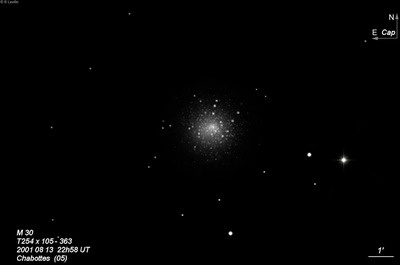
Charles Messier discovered M30 = NGC 7099 = h2128 = h3878 on 3 Aug 1764. WH first observed the globular on 31 Jul 1783 using his 12-inch (small 20-foot) and reported "Power 200; it consists of very small stars; with two rows of stars, 4 or 5 in a line." He later wrote, "It is a difficult step i.e. if we divide the transition from the Pleiades down to the Nebula in Orion into six steps, this perhaps the 4th towards the real nebulas. The stars in this seem to be of two different sizes for I perceive 3 or 4 very visible ones branching out towards the north and several more exceedingly small at the sides. Towards the south in one place the light is very intense, but has all the appearance of crowded stars; so that there remains no doubt of the whole being stars."
In PT 1814, WH summarized his observations of M30 as a "brilliant cluster, the stars of which are gradually more compressed in the middle. It is insulated, that is, none of the stars in the neighborhood are likely to be connected with it. Its diameter is from 2' 40" to 3' 30". Its figure is irregularly round. The stars about the centre are so much compressed as to appear to run together. Towards the north, are two rows of bright stars 4 or 5 in a line." He speculated in his 1814 publication that the "lines of bright stars, although by a drawing made at the time of observation, one of them seems to pass through the center, are probably not connected with it."
JH made the following detailed observation on 23 Sep 1830: "Fine cluster; irreg R, with two projections A, B, at its northern side. (See fig. 90.) A is directed from the central brightness and consists of 3 or 4 bright stars 12 m; its position taken with microm = 350.4°; B originates in the preceding side of the centre, and is directed in a position 331.7° in a line not passing the centre; diam = 6', stars = 12m; fine object; has a * 9 m preceding it (2 or 3 diameters by diagram)." From the Cape of Good Hope, he logged "Globular, B; lE; bM; 4' l, 3' br; all resolved into st 16m, besides a few 12m. Two lines of rather larger stars run out n[orth f[ollowing]."
200/250mm - 8" (10/4/80): two short straight star lanes to north and NW give a unique "prong" appearance. A few faint stars are resolved southeast of the core but the core is unresolved.
300/350mm - 13.1" (9/29/84): fascinating view at 350x; ~25 stars resolved in the outer halo. A few stars (half dozen) are bunched together near the bright, unresolved irregular core over a fainter diffuse halo.
13.1" three star lanes are obvious on the north side. Good resolution in the halo and outer stragglers. The core appears on the verge of resolution at 288x.
400/500mm - 17.5" (8/17/01): viewed at 575x in excellent seeing. Very irregular appearance with strings of stars emanating from an irregular bright, partially resolved core. A prong off the west side heads northwest and includes three equally spaced similar stars along with a close triple. Another bright line of three stars heads due north with a fainter bent elbow of stars angling towards the NE. Roughly a dozen stars trail to the east with a large gap towards the edge of the halo. A fairly well defined semi-circle of stars open to the north passes directly through the core and off the SE side. The outer halo is peppered with dozens of faint stars over a dim background haze and with concentration the overall diameter increases significantly to at least 10'.
17.5" (7/5/86): the small bright core was not resolved but the halo was well resolved into 50-60 stars. A small circular detached piece is east of the core with resolved stars. Along the north side the resolved stars are brighter and arranged in lanes.
900/1200mm - 48" (10/27/19 and 10/24/14): at 375x; several hundred stars were resolved right down to a small brighter nucleus. Several very bright stars were in chains that emanated from the core. The halo seemed fully resolved with a very large range in magnitudes. The outer halo was scraggly and contained some bright stars, but overall the halo was fairly symmetric.
The first of three bright stars in a string directly to the north of the core (~40" N of center) was clearly orange (red-giant) as well as the first of a string of three bright stars starting at the west edge of the core (~55" W of center) extending northwest. A few other brighter stars either appear yellow or very pale orange!
Notes by Steve Gottlieb
NGC 6907
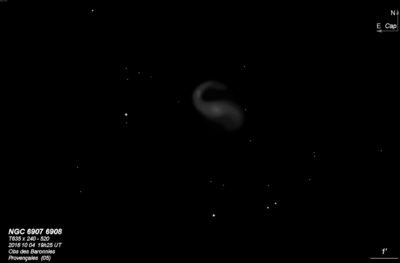
William Herschel discovered NGC 6907 = H III-141 = h2076 on 12 Jul 1784 (sweep 236) and recorded "a pretty considerable vF nebula, lE, vlbM than at the extremes. 240 showed the same appearance; it makes a trapezium with 3 stars and is at the northern and following corner of it." JH made the single observation (from Slough), "vF; L; R; vglbM; 3' diam; r; the sky hazy." His position is accurate. In a 5-inch refractor at Vanderbilt, Barnard called it "faint and somewhat faint; it is close preceding a 9-magnitude star, and is gradually pretty much brighter in the middle."
400/500mm - 17.5" (8/8/02): beautiful view at 220x. This barred spiral appeared moderately bright and large with a fairly bright bar elongated "bar" oriented ~E-W with a small bright core. At the following end of the bar an obvious arm is attached is attached sweeping north of the galaxy in a comma-like appendage. On the preceding end there seems to be a faint knot and there is a very short extension bending south that quickly fades out.
17.5" (9/14/85): at 192x appears moderately bright, bright core, elongated E-W. Barred spiral structure is evident; fainter extensions form the bar and an arm at the eastern end of the bar curves north and then hooks slightly back to the west. This spiral arm appears to end at a faint knot. Two mag 11.5 stars lie 3' E and a similar distance south.
600/800mm - 24" (8/14/15): the companion galaxy superimposed on the eastern arm was clearly visible and fairly well defined, elongated 5:2 N-S, ~20"x8".
24" (7/25/14): striking example of a barred spiral with a prominent 1.5'x0.5' central bar oriented directly east-west. The bar contains a bright 30" core, which increases to a quasi-stellar nucleus. A bright arm is attached at the east end of the bar and extends due north for 0.7', at a right angle to the bar. A bright, elongated N-S "knot" is embedded in the middle (superimposed companion NGC 6908). At the north end, the arm curls west a short distance while dimming out. A difficult, ill-defined arm is attached at the west end of the bar. It vaguely curves south and west, but quickly disappears into very low surface brightness haze.
24" (9/15/12): excellent barred spiral with the 1.5' central bar oriented E-W. The bar has a small, brighter core that increases to a faint stellar nucleus. On the east side of the bar a prominent spiral arm is attached that hooks at a 90° angle to the north for ~45". The arm dims and curves clockwise to the west a short distance, creating a "comma" appearance in the eyepiece with north down and west left. There is a noticeable elongated brightening or N-S streak in the arm at the northern end (before curving west). This streak is NGC 6908, a superimposed companion. On the west side of the bar, the beginning of a low surface brightness arm (hazy extension) bends southwest a very short distance and dims out.
900/1200mm - 48" (10/25/14): the central 1.2' bar of NGC 6907 runs E-W and contained a bright core and very bright nucleus that increased to the center. The more prominent spiral arm is attached on the east end of the bar and the section that hooks north contains NGC 6908, a superimposed galaxy. It appeared fairly bright, elongated 3:1 N-S, ~21"x7", very small bright core -- and appeared distinctly as a separate galaxy. A mag 16 star is just off the northeast end of NGC 6908. The arm bends clockwise west and dims as it extends to nearly the west end of the central bar (much further than seen with my 24"). The southern arm was fainter, more diffuse and broader, but swept around to the east on the south side of the halo, reaching nearly to the east end of the central bar. Two non-stellar HII knots (~10" diameter) were seen along this arm and they made an equilateral triangle with the nucleus; the brighter knot is at the west end of this arm, 0.8' SE of center, and a second knot lies 0.8' SSW of center.
Notes by Steve Gottlieb
NGC 6903
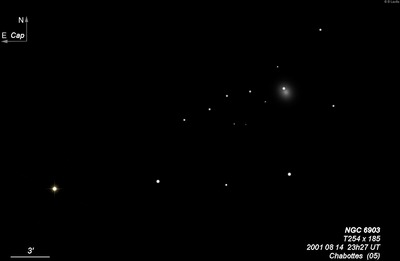
John Herschel discovered NGC 6903 = h2073 on 14 Jul 1830 and recorded "a * 10m, with a considerable nebulous appendage sp, in which by glimpses may be fancied a star 15m." A total of 3 observations were made. This galaxy wasn't found on two attempts at Birr Castle in the 1850s, though it was later observed in the 1860's. d'Arrest followed up with two observations at Copenhagen in 1864 with the 11" refractor and commented it was hard to understand how Rosse missed this object.
400/500mm - 17.5" (8/5/91): fairly faint, very small, round, very small bright core. Very unusual appearance as a mag 10 star is attached at the NNE end. The main body of the galaxy just extends up to the bright star but an extremely faint larger halo was suspected to encompass the bright star.
Notes by Steve Gottlieb
Pal 12
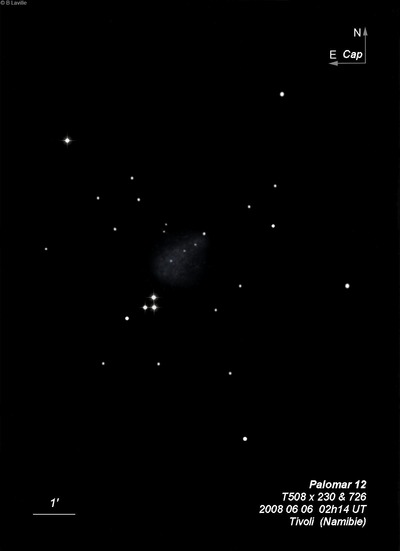
| Type | GC [XII] |
| RA | 21:46:30.0 |
| Dec | -21:15:00.0 |
| major_axis | 2.9' |
| mag | 11.7 |
| surface_bright | 13.8 |
